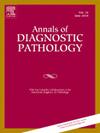Myxoid adrenocortical adenoma with pseudoglandular pattern: A clinicopathological study of a rare histologic variant and its diagnostic challenges
IF 1.5
4区 医学
Q3 PATHOLOGY
引用次数: 0
Abstract
Objective
Myxoid adrenocortical adenoma (MAA) with a pseudoglandular pattern is a rare variant of adrenal cortical tumors, characterized by a prominent myxoid matrix and diverse architectural patterns. Due to its overlapping features with malignant and metastatic myxoid tumors, it poses significant diagnostic challenges. This study aimed to delineate the clinicopathologic, immunohistochemical, and differential diagnostic features of MAA based on a case series.
Methods
We retrospectively analyzed nine cases of MAA diagnosed between 2015 and 2023. Comprehensive clinicoradiologic, histopathologic, and immunophenotypic data were collected. Histologic evaluation included Weiss scoring, mitotic activity, and reticulin framework analysis. Immunohistochemistry was performed using a panel of markers including α-inhibin, Melan-A, Synaptophysin, CD56, CK, Vimentin, S100, and HMB45. Alcian blue and AB-PAS staining were applied to assess mucin content. All cases were followed for postoperative outcomes.
Results
The cohort included 5 females and 4 males, with a median age of 40 years (range 27–53). Tumor sizes ranged from 2.2 to 7.4 cm (mean 4.1 cm). Grossly, all tumors were well-demarcated, solid, and mucin-rich without evidence of necrosis or vascular invasion. Histologically, all cases exhibited abundant extracellular myxoid stroma (mean proportion: 78.3 %) and diverse pseudoglandular, cord-like, and sieve-like architectures. Tumor cells were polygonal with eosinophilic or hyaline cytoplasm and minimal atypia. No mitotic figures >2/20 HPF were observed. Immunohistochemistry showed diffuse positivity for α-inhibin (100 %), Melan-A (88.9 %), CD56 (77.8 %), Synaptophysin (66.7 %), and Vimentin (100 %), while S100, HMB45, and Chromogranin A were consistently negative. Ki-67 index was <3 % in all cases. Alcian blue was strongly positive in 77.8 % of tumors, supporting the myxoid component. During a median follow-up of 14 months, no recurrence or metastasis occurred.
Conclusions
MAA with a pseudoglandular pattern is a benign but diagnostically challenging adrenal neoplasm due to its histologic overlap with myxoid adrenal cortical carcinoma and metastatic mucinous tumors. Recognition of its characteristic morphology, immunoprofile, and benign clinical course is critical to prevent overtreatment. Incorporating Weiss criteria, reticulin staining, and a myxoid tumor differential panel enhances diagnostic accuracy in clinical practice.
具有假腺型的黏液样肾上腺皮质腺瘤:一种罕见的组织学变异及其诊断挑战的临床病理研究
目的假腺样样肾上腺皮质腺瘤(MAA)是一种少见的肾上腺皮质肿瘤,其特点是粘液样基质突出,结构形态多样。由于其与恶性和转移性黏液样肿瘤的重叠特征,它提出了重大的诊断挑战。本研究旨在根据一系列病例描述MAA的临床病理、免疫组织化学和鉴别诊断特征。方法回顾性分析2015 ~ 2023年确诊的9例MAA病例。收集了全面的临床放射学、组织病理学和免疫表型数据。组织学评价包括Weiss评分、有丝分裂活性和网状蛋白框架分析。采用α-抑制素、Melan-A、Synaptophysin、CD56、CK、Vimentin、S100、HMB45等标记物进行免疫组化。阿利新蓝染色和AB-PAS染色测定粘蛋白含量。对所有病例进行术后随访。结果本组患者女性5例,男性4例,年龄27 ~ 53岁,中位年龄40岁。肿瘤大小为2.2 ~ 7.4 cm(平均4.1 cm)。肉眼可见,所有肿瘤界限清晰,实心,粘液丰富,无坏死或血管侵犯迹象。组织学上,所有病例均表现出丰富的细胞外黏液样间质(平均比例:78.3%)和多样的假腺样、索样和筛样结构。肿瘤细胞呈多角形,细胞质嗜酸性或透明,极少有异型性。未观察到有丝分裂现象>;2/20 HPF。免疫组化结果显示α-抑制素(100%)、Melan-A(88.9%)、CD56(77.8%)、Synaptophysin(66.7%)、Vimentin(100%)弥漫性阳性,而S100、HMB45、Chromogranin A均呈阴性。Ki-67指数均为3%。阿利新蓝在77.8%的肿瘤中呈强阳性,支持黏液成分。在中位随访14个月期间,未发生复发或转移。结论假腺型maa是一种良性肾上腺肿瘤,与肾上腺皮质粘液样癌和转移性黏液瘤有组织学上的重叠,诊断上具有挑战性。识别其特征形态,免疫谱和良性临床过程是防止过度治疗的关键。结合Weiss标准,网状蛋白染色和黏液样肿瘤鉴别面板提高了临床实践中的诊断准确性。
本文章由计算机程序翻译,如有差异,请以英文原文为准。
求助全文
约1分钟内获得全文
求助全文
来源期刊
CiteScore
3.90
自引率
5.00%
发文量
149
审稿时长
26 days
期刊介绍:
A peer-reviewed journal devoted to the publication of articles dealing with traditional morphologic studies using standard diagnostic techniques and stressing clinicopathological correlations and scientific observation of relevance to the daily practice of pathology. Special features include pathologic-radiologic correlations and pathologic-cytologic correlations.

 求助内容:
求助内容: 应助结果提醒方式:
应助结果提醒方式:


